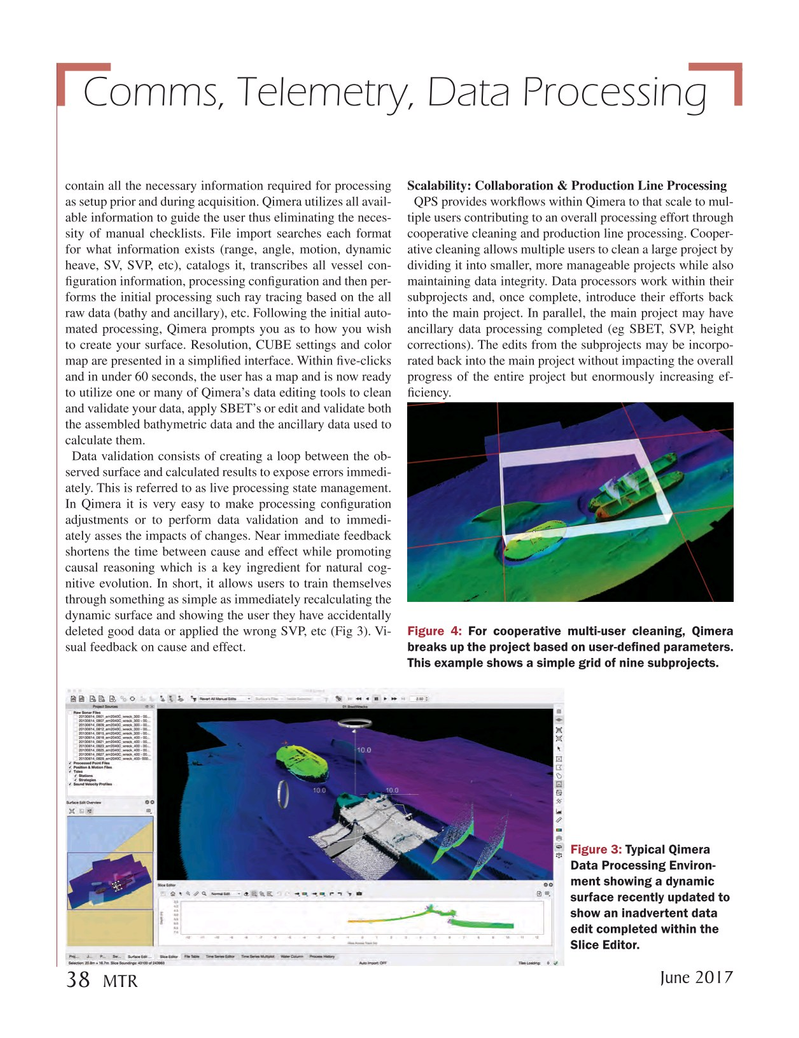
Page 38: of Marine Technology Magazine (June 2017)
Hydrographic Survey
Read this page in Pdf, Flash or Html5 edition of June 2017 Marine Technology Magazine
Comms, Telemetry, Data Processing contain all the necessary information required for processing Scalability: Collaboration & Production Line Processing as setup prior and during acquisition. Qimera utilizes all avail- QPS provides work? ows within Qimera to that scale to mul- able information to guide the user thus eliminating the neces- tiple users contributing to an overall processing effort through sity of manual checklists. File import searches each format cooperative cleaning and production line processing. Cooper- for what information exists (range, angle, motion, dynamic ative cleaning allows multiple users to clean a large project by heave, SV, SVP, etc), catalogs it, transcribes all vessel con- dividing it into smaller, more manageable projects while also ? guration information, processing con? guration and then per- maintaining data integrity. Data processors work within their forms the initial processing such ray tracing based on the all subprojects and, once complete, introduce their efforts back raw data (bathy and ancillary), etc. Following the initial auto- into the main project. In parallel, the main project may have mated processing, Qimera prompts you as to how you wish ancillary data processing completed (eg SBET, SVP, height to create your surface. Resolution, CUBE settings and color corrections). The edits from the subprojects may be incorpo- map are presented in a simpli? ed interface. Within ? ve-clicks rated back into the main project without impacting the overall and in under 60 seconds, the user has a map and is now ready progress of the entire project but enormously increasing ef- to utilize one or many of Qimera’s data editing tools to clean ? ciency.
and validate your data, apply SBET’s or edit and validate both the assembled bathymetric data and the ancillary data used to calculate them.
Data validation consists of creating a loop between the ob- served surface and calculated results to expose errors immedi- ately. This is referred to as live processing state management.
In Qimera it is very easy to make processing con? guration adjustments or to perform data validation and to immedi- ately asses the impacts of changes. Near immediate feedback shortens the time between cause and effect while promoting causal reasoning which is a key ingredient for natural cog- nitive evolution. In short, it allows users to train themselves through something as simple as immediately recalculating the dynamic surface and showing the user they have accidentally deleted good data or applied the wrong SVP, etc (Fig 3). Vi- Figure 4: For cooperative multi-user cleaning, Qimera sual feedback on cause and effect. breaks up the project based on user-de? ned parameters.
This example shows a simple grid of nine subprojects.
Figure 3: Typical Qimera
Data Processing Environ- ment showing a dynamic surface recently updated to show an inadvertent data edit completed within the
Slice Editor.
June 2017 38
MTR
MTR #5 (34-47).indd 38 MTR #5 (34-47).indd 38 5/25/2017 2:37:39 PM5/25/2017 2:37:39 PM

 37
37

 39
39
